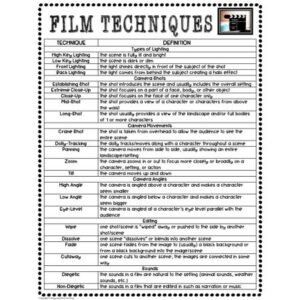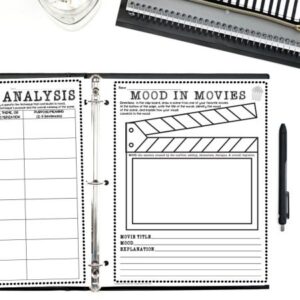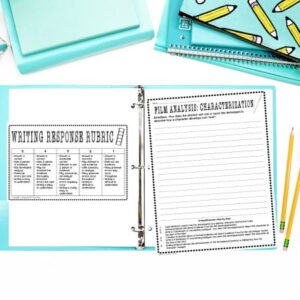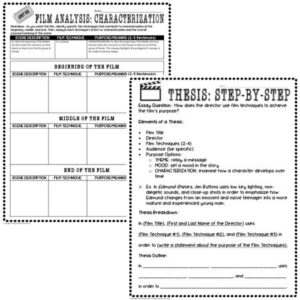Have you considered introducing a movie analysis unit this school year, but need teaching film techniques worksheets to make the job easier? While many educators tend to avoid teaching movies due to certain stigmas or a lack of knowledge on the topic, I strive to integrate films wherever possible.
Teaching film techniques worksheets makes the process smoother and easier for both students and teachers! Being able to print and teach with reliable and relatable resources is vital to my own pedagogy, as it assists both my students and me in delving into what makes a film truly great.
So, let’s raise the standard and include rigorous teaching film techniques worksheets within our middle and high school classrooms this year! Keep reading for 20 Proven Teaching Film Techniques Worksheets!
Need help with Test Prep? Check out this FREE Pack of 3 Test Prep Activities to help students achieve success on standardized tests!
20 Proven Teaching Film Techniques Worksheets & Activities
Introducing a Movie Unit
Before teaching film techniques worksheets, it is essential to begin with an introduction to film analysis. I use critical thinking activities that connect to one another and ultimately lead students to see film techniques in action. If you follow the activities below in order, your students will enjoy the movie analysis unit so much more! This scaffolding is vital!
1. Discuss Favorite Films
Students enjoy talking about movies. I have yet to teach a student who cannot name at least one movie they love! Heck, if students claim they don’t have a favorite movie, ask about a movie they simply remember and why.
Then, take the time to model a list of your own favorite films. Students’ lists may be completely different from yours, but they will likely enjoy chatting with you and other students about the movies they have watched, especially those from their childhood.
Use this Favorite Films Organizer in my store, which is a part of my teaching film techniques worksheets resource!
2. Define Specific Film Techniques
Most students are not familiar with teaching film techniques worksheets and activities because they are typically not taught in courses outside of a film studies course in college. To start, I like going through the process of defining a list of film techniques I see most frequently in high-quality movies, such as types of lighting, editing strategies, camera movements, etc.
When introducing lighting, you might want to define high key lighting (the scene is fully lit and bright) and low key lighting (the scene is dark or dim).
I prefer letting students take notes as I read aloud these techniques and their definitions, rather than printing a list for all students. When they write down, they remember!
See the list here in this teaching film techniques worksheets resource!
3. Provide Examples of Film Techniques
This part is so much fun! Since most of us have access to suitable online film clips, we can easily demonstrate examples of film techniques. Older suspenseful films directed by Alfred Hitchcock are my go-to examples for modeling what film techniques look like in action.
You might also display a specific film’s static image to illustrate a particular technique.
Viewing the first 10 minutes or so of most movies will be enough for examples of an establishing shot or other techniques!
I like using film clips from classic movies (most are appropriate in terms of content and not graphic):
- Mr. Smith Goes to Washington
- A Raisin in the Sun
- 12 Angry Men
- Hidden Figures
- Ben-Hur
- The Wizard of Oz
- To Catch a Thief
- Rear Window
- Annie
- My Fair Lady
- Singing in the Rain
- Remember the Titans
- October Sky
- Stand and Deliver
- Edward Scissorhands
- The Princess Bride
- The Karate Kid
Really, the list could go on, but I prefer to showcase movies that most students have not seen before, especially when incorporating teaching film techniques worksheets within a movie unit or as integrated texts throughout the year!
4. Offer Open-Ended Questions for Real Movies
Most often, we watch movies without any sort of critical thinking going on. Instead, we sit and get, and rarely go beneath the surface of a film.
So I like to ask questions about the use of film techniques:
- Why might a director use a close-up?
- What do you notice about the close-up in this shot?
- What is the effect of this close-up?
- What story might be told through this close-up?
As students begin to consider these questions about the director’s use of various techniques, they will comprehend and examine what is presented to them with a more critical eye.
5. Challenge students with a Film Techniques Quiz
You could use a quick quiz or a Boom Cards quiz to assess students’ knowledge. Memorizing film techniques is extremely helpful as students progress into the movie unit.
Click here for an easy-to-use quiz within my teaching film techniques worksheets resource!
Need ideas for teaching short stories this fall? Check out the post below!
Mood
6. Movie Moods Opening
Mood is one of the easiest concepts to teach within a film analysis unit, so I usually start with it!
Mood is the emotion created by the conflict, setting, characters, dialogue, overall depiction, etc. (Ex. gloomy, lighthearted, melancholy, peaceful, calm, energetic, inspiring, dreamy, cheerful, etc.)
Students can describe the moods of their favorite film scenes in the MOVIE MOODS worksheet. Offer time to share out their visuals!
7. Show “Moody” Clips
Many fantastic movies offer diverse moods, which are perfect for teaching film techniques worksheets.
Anything by Tim Burton is fantastic. In fact, viewing the beginning of Edward Scissorhands is a great place to start. Let students identify the mood of various points of the first fifteen minutes or so of the movie.
Additionally, you may want students to look up mood words for help before tackling the Teaching Film Techniques Worksheets!
8. Model Mood Analysis
Ultimately, we want students to reach a point of analysis through the use of teaching film techniques worksheets. I like teaching film techniques worksheets and organizers that allow for ease of use, like this one!
| SCENE DESCRIPTION | FILM TECHNIQUE | PURPOSE/MEANING (2-3 Sentences) |
Here is an example to model for your students:
| SCENE DESCRIPTION | FILM TECHNIQUE | PURPOSE/MEANING (2-3 Sentences) |
| Ex. At the start of Tranquility, the brother rescues his sister from a facility that holds her captive for her mental and physical abilities. | Ex. High Angle
Ex. Low Angle |
MOOD: Ex. As the siblings are attempting to escape, they look down from a high angle into lasers that would limit their escape and then up at a low angle into their means of escape. These angles create a sense of tension and urgency. |
Notice. The goal is to get students to consider how the techniques are being used and their effects! Several sentences for each entry and a couple of entries will prepare students for the next step!
9. Write About Mood
While I ultimately want students to be able to write a fully developed film analysis, I start with paragraphs based on the students’ organizers from the film clips. There are several prompts you might use to guide students in this process:
- What film technique is used in this clip, and what mood does it evoke?
- How is mood developed through at least two techniques in this scene?
- How does the mood change with the use of varied film techniques?
Here is a paragraph outline you might use for an entire movie:
Writing Response: Step-By-Step
1. Topic Sentence- Introduce the movie/director and connect the film techniques to a change in mood from beginning to middle, middle to end, or beginning to end
2. Textual Evidence- Cite direct evidence from the movie (technique/scene)
3. Write 2-4 sentences of commentary/analysis; what does the technique/scene reveal about a specific mood?
4. Transition to another piece of textual evidence- Cite direct evidence from the movie (technique/ scene)
5. Write 2-4 sentences of commentary/analysis; what does the technique/scene reveal about the mood?
6. Ending sentence- Discuss the effectiveness of the techniques/scenes in depicting how the mood changes
By giving an outline, students have a roadmap that will lead to greater success as they analyze movies!
10. Create a Mood Movie Poster
If you have time, students could be given a mood word and create a movie poster based on that word! The movie could be real or one of their own imagination.
Then, in a Gallery Walk, other students could guess the mood of each poster based on various details. Completing this activity is a wonderful addition to a movie unit with teaching film techniques worksheets!
Characterization
11. Explain Characterization
You might think that characterization is too easy for secondary students; however, teaching students how to examine the development of characterization can be a challenging process. To familiarize students with this concept, I like to relate it to their lives.
Complex Characters- Explain that authors write about people and/or characters with many physical, mental, and emotional dimensions/traits.
Students can begin analyzing this standard by thinking about their own personal interesting physical (Ex. athletic, brown-eyed, short), mental (Ex. intelligent, determined, knowledgeable), and emotional (Ex. dramatic, shy, excitable) traits.
See this free My Traits Worksheet for help!
12. Identify Famous Movie Characters’ Traits
After students know about different character traits, they can identify their favorite characters in movies and complete the MOVIE CHARACTERS & THEIR CHARACTERISTICS worksheet.
Ex. The Little Princess– Sara is sweet, young, and generous.
Check out the teacher examples for help!
13. Model Film Techniques Analysis for Characterization
Guiding students through the step-by-step process for effective film analysis requires teaching film analysis worksheets to make the job streamlined.
See this example you can use with your students!
| DESCRIPTION OF THE SCENE | FILM TECHNIQUE | CHARACTER
TRAIT |
IMPACT/MEANING
(2-3 Sentences) |
| Ex. The opening credits of Sci-Fi show images of objects that turn out to be shavings of skin, hair, and nail clippings. | Ex. Extreme Close-Up
Ex. Close-Up |
CHARACTERIZATION: Ex. These extreme close-up shots connect to the protagonist in his struggle to become more than what society will allow. They reveal his desire to change and his willingness to do whatever it takes to achieve his goals. | Ex. The opening credits of Sci-Fi show images of objects that turn out to be shavings of skin, hair, and nail clippings. This scene and use of the techniques contribute to intrigue concerning the protagonist’s motivation. |
14. Write About Characterization
After taking notes in the above organizer, you might have students write the first sentence only (like a thesis), the first half of a paragraph, or a complete paragraph with two or more pieces of evidence. It is totally up to you.
By incorporating the above teaching films analysis worksheets, students can use what they have already identified, analyzed, and written about to create a simple but productive paragraph!
15. Visualize Oneself as a Movie Character
Clearly, I enjoy teaching movies! Perhaps it is because I love to see my life as one big movie. I am essentially the movie hero of my own life!
To give students a chance to feel the same way, why not allow students to visualize themselves as a hero in their life movie? It doesn’t have to take up a class period, and it will be a fun way to segue into higher-level activities!
Theme
16. Explore Theme
First, define theme and have students generate themes about fairy tales or stories they have read throughout the year!
Theme- a theme is a message, usually written in a complete sentence
Ex. Love requires sacrifice.
Ex. Attaining one’s dream will always be a difficult process.
Most importantly, students need to understand that themes require fully developed sentences that relay messages about what they have read or seen!
17. Determine Theme in Movies
After explaining what a theme is, you could even have students come up with their own themes about their favorite movies in the MOVIES & MEMORIES worksheet. Check out the example below from a classic!
Ex. 20,000 Leagues Under the Sea
Ex. Technology results in unexpected and uncontrollable outcomes.
With examples, students will be able to conceptualize the higher-level activities later on in the teaching film techniques worksheets unit!
18. Model Theme Analysis
Like Mood and Characterization, be sure to use teaching film techniques worksheets that link to theme as well. See the example below for assistance in writing about theme!
| DESCRIPTION OF THE SCENE | FILM TECHNIQUE | THE
THEME |
IMPACT/MEANING
(2-3 Sentences) |
| Ex. In Shakespeare’s Star-Crossed Lovers, a fight breaks out between the Capulet and Montague kinsmen; it causes a fire to consume the station, and through the fire and smoke, the audience can see the city of Verona. | Ex. Long-Shot
Ex. Establishing Shot |
Ex. These shots strengthen the message that contention between people will ultimately affect others and lead to their destruction. | Ex. The long shots of the city and the establishing shot of the setting and characters at the station underscore the misguided hatred between the two families. Even the distance of the shots emphasizes the very real chasm between the two families. |
19. Write About Theme
When students write about a theme in a movie or any other text, we want them to identify more than a topic or two. Below are sample questions to help students stay focused on a message (theme) in a movie:
- What does the film reveal about time?
- What message does the film convey about relationships?
- How does the director use techniques to bolster a message about family?
As students respond to a film’s theme or multiple themes, using evidence is key. In utilizing the teaching film techniques worksheets and organizers, you should be able to see a 9-10 sentence paragraph in 20 minutes or less!
20. Extend Paragraphs into a Film Analysis Essay
While I incorporate teaching film techniques worksheets into the movie unit, my goal is for students to write a fully developed essay. Not everything in school has to end in an essay, but many students are not actually writing as much as we would like.
If your students have completed the teaching film techniques worksheets, writing an essay is no big deal. Here are several prompts you might consider using one to three movies:
- How do different directors use film techniques to evoke mood?
- What is the effect of similar film techniques in the two films’ depictions of characterization?
- What various themes are conveyed through at least three film techniques in the movie?
You can make the essay as simple or complex as you would like. You might start with the mood with struggling students or ask students to write about multiple movies in terms of themes. The options are endless!
Teaching Film Techniques Worksheets Resource
Want to teach movies with engaging activities? This Teaching Film Techniques Worksheets BUNDLE is a FUN and EASY way to incorporate the analysis of movies into your classroom. You and your students will find this teaching film techniques worksheets bundle helpful as they work to examine how film techniques contribute to the purpose of any film.
Need more teaching film techniques worksheets? Check out my store, Kristin Menke-Integrated ELA Test Prep!










